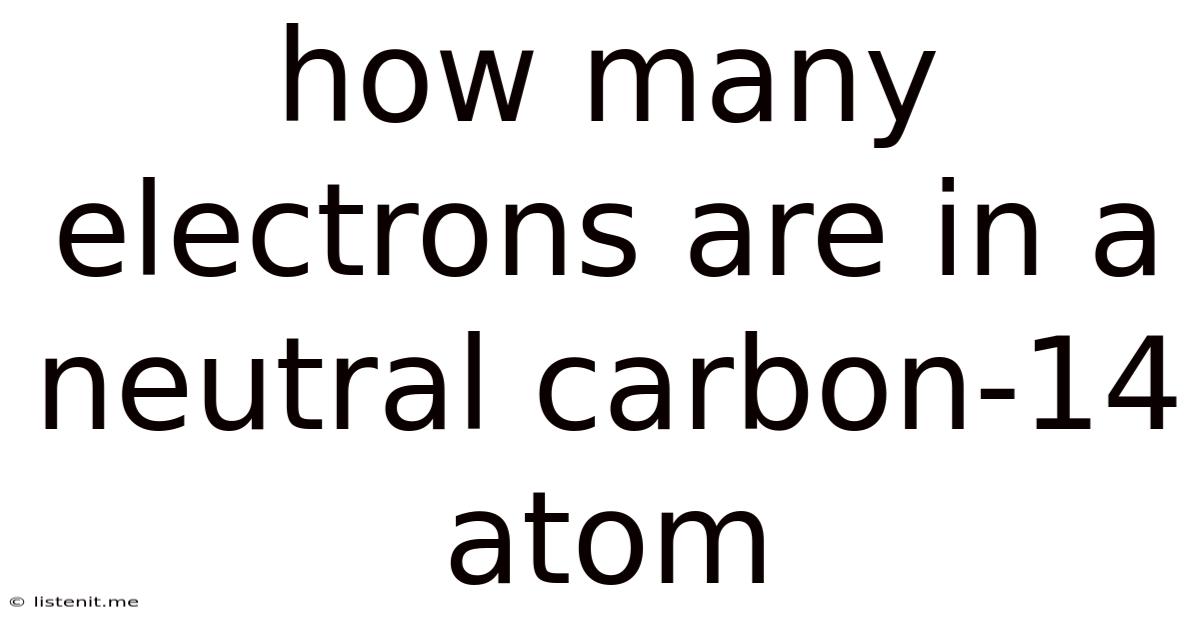How Many Electrons Are In A Neutral Carbon-14 Atom
listenit
May 09, 2025 · 5 min read

Table of Contents
How Many Electrons Are in a Neutral Carbon-14 Atom? Understanding Atomic Structure and Isotopes
The question of how many electrons are in a neutral carbon-14 atom is deceptively simple, yet it opens the door to understanding fundamental concepts in chemistry and physics, specifically atomic structure and isotopes. The answer itself is straightforward, but the journey to understanding why that's the answer provides valuable insights into the nature of matter.
Understanding Atomic Structure: Protons, Neutrons, and Electrons
Before we delve into carbon-14, let's establish a foundational understanding of atomic structure. An atom, the basic building block of matter, comprises three primary subatomic particles:
- Protons: Positively charged particles residing in the atom's nucleus (core). The number of protons defines the element; it's the atomic number.
- Neutrons: Neutral (uncharged) particles also located within the nucleus. Neutrons, along with protons, contribute to the atom's mass.
- Electrons: Negatively charged particles orbiting the nucleus in electron shells or energy levels. These shells have varying energy levels, and electrons fill them according to specific rules.
The number of protons dictates the element's identity. For example, all atoms with six protons are carbon atoms. The number of neutrons, however, can vary, leading to isotopes.
Isotopes: Variations on a Theme
Isotopes are atoms of the same element (same number of protons) but with different numbers of neutrons. This difference in neutron count alters the atom's mass but not its chemical properties significantly. Carbon, for instance, has several isotopes, including carbon-12 (¹²C), carbon-13 (¹³C), and carbon-14 (¹⁴C). The number after the element's name represents the mass number – the total number of protons and neutrons in the nucleus.
Carbon-14: The Radioactive Isotope
Carbon-14 is a naturally occurring radioactive isotope of carbon. It has six protons (like all carbon atoms) and eight neutrons (14 - 6 = 8), giving it a mass number of 14. The radioactivity stems from its instability; its nucleus undergoes radioactive decay, transforming into nitrogen-14 over time. This decay process is crucial for carbon dating, a method used to determine the age of organic materials.
Determining the Number of Electrons in a Neutral Carbon-14 Atom
Now, we arrive at the core question: how many electrons are in a neutral carbon-14 atom?
A neutral atom possesses an equal number of protons and electrons. This balance of positive and negative charges ensures the atom has a net charge of zero. Since carbon-14 has six protons, a neutral carbon-14 atom must also have six electrons. The number of neutrons does not affect the number of electrons in a neutral atom. The neutrons contribute to the mass but not the overall charge.
Visualizing Electron Configuration
Electrons occupy specific energy levels or shells around the nucleus. For carbon-14 (and all carbon atoms), the electron configuration is:
- First shell (K shell): 2 electrons
- Second shell (L shell): 4 electrons
This arrangement reflects the filling of electron shells according to the Aufbau principle and Hund's rule, concepts fundamental to understanding electron behavior and chemical bonding.
Significance of Carbon-14 and its Applications
The unique properties of carbon-14 make it invaluable in various scientific fields:
1. Radiocarbon Dating: Unveiling the Past
The radioactive decay of carbon-14 follows a predictable half-life (approximately 5,730 years). By measuring the remaining amount of carbon-14 in organic materials (e.g., ancient wood, bones, textiles), scientists can estimate their age. This technique revolutionized archaeology, paleontology, and other historical studies.
2. Tracing Biological Processes: Metabolic Studies
Carbon-14's incorporation into biological molecules allows researchers to track metabolic pathways and study the fate of specific compounds within living organisms. This is critical in understanding biological processes at a molecular level.
3. Environmental Science and Monitoring: Atmospheric Studies
Carbon-14 is used to study atmospheric processes, including the mixing of atmospheric gases and the carbon cycle. It provides valuable insights into climate change and environmental pollution.
4. Medical Applications: Radiotracer Studies
While less common than other radioisotopes, carbon-14 finds limited application in medical research as a tracer in various metabolic studies.
Beyond the Basics: Ions and Charged Atoms
It's important to note that our discussion focuses on neutral carbon-14 atoms. If a carbon-14 atom loses or gains electrons, it becomes an ion – a charged particle.
- Carbon-14 cation: If a carbon-14 atom loses one or more electrons, it carries a positive charge (e.g., C⁺, C²⁺).
- Carbon-14 anion: If a carbon-14 atom gains one or more electrons, it carries a negative charge (e.g., C⁻, C²⁻).
The number of electrons in an ion differs from that of a neutral atom; the charge indicates the imbalance between protons and electrons.
Conclusion: A Deeper Understanding
While the answer to the question—six electrons in a neutral carbon-14 atom—is simple, the underlying concepts are profound. Understanding atomic structure, isotopes, and the behavior of electrons is crucial for comprehending the world around us. Carbon-14, with its unique radioactive properties, plays a significant role in various scientific disciplines, highlighting the importance of this seemingly simple atom. Its applications in dating ancient artifacts, tracing biological processes, and studying environmental changes underscore its scientific significance. By grasping the fundamental principles of atomic structure, we unlock a deeper understanding of the universe at its most basic level.
Latest Posts
Latest Posts
-
Greatest Common Factor Of 10 And 20
May 11, 2025
-
How To Find If A Triangle Is Right
May 11, 2025
-
What Percent Is 36 Out Of 45
May 11, 2025
-
An Atom With An Electrical Charge Is An
May 11, 2025
-
80 Expressed As A Fraction Is
May 11, 2025
Related Post
Thank you for visiting our website which covers about How Many Electrons Are In A Neutral Carbon-14 Atom . We hope the information provided has been useful to you. Feel free to contact us if you have any questions or need further assistance. See you next time and don't miss to bookmark.